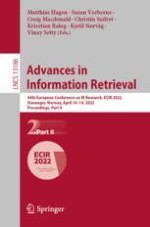2022 | Buch
Advances in Information Retrieval
44th European Conference on IR Research, ECIR 2022, Stavanger, Norway, April 10–14, 2022, Proceedings, Part II
herausgegeben von: Matthias Hagen, Suzan Verberne, Craig Macdonald, Christin Seifert, Krisztian Balog, Kjetil Nørvåg, Vinay Setty
Verlag: Springer International Publishing
Buchreihe : Lecture Notes in Computer Science
